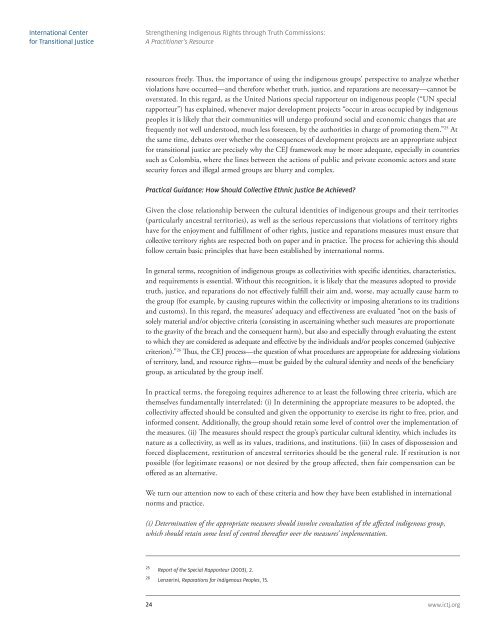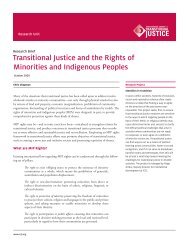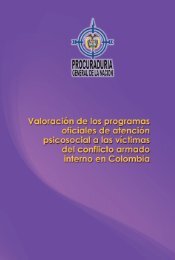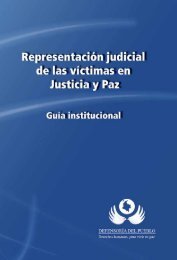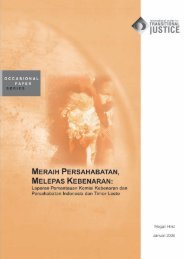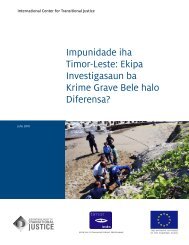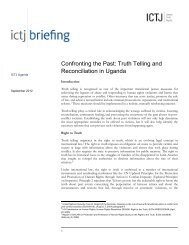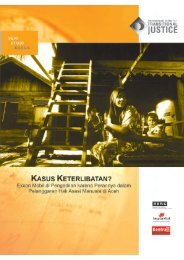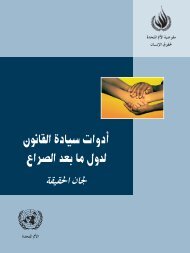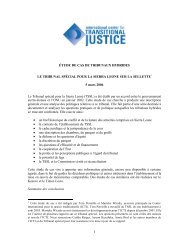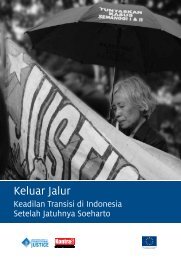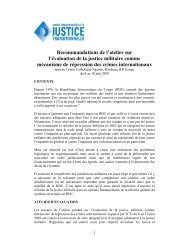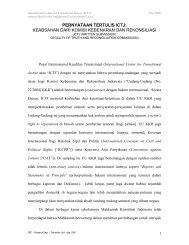Strengthening Indigenous Rights through Truth Commissions: A ...
Strengthening Indigenous Rights through Truth Commissions: A ...
Strengthening Indigenous Rights through Truth Commissions: A ...
- No tags were found...
You also want an ePaper? Increase the reach of your titles
YUMPU automatically turns print PDFs into web optimized ePapers that Google loves.
International Centerfor Transitional Justice<strong>Strengthening</strong> <strong>Indigenous</strong> <strong>Rights</strong> <strong>through</strong> <strong>Truth</strong> <strong>Commissions</strong>:A Practitioner’s Resourceresources freely. Thus, the importance of using the indigenous groups’ perspective to analyze whetherviolations have occurred—and therefore whether truth, justice, and reparations are necessary—cannot beoverstated. In this regard, as the United Nations special rapporteur on indigenous people (“UN specialrapporteur”) has explained, whenever major development projects “occur in areas occupied by indigenouspeoples it is likely that their communities will undergo profound social and economic changes that arefrequently not well understood, much less foreseen, by the authorities in charge of promoting them.” 25 Atthe same time, debates over whether the consequences of development projects are an appropriate subjectfor transitional justice are precisely why the CEJ framework may be more adequate, especially in countriessuch as Colombia, where the lines between the actions of public and private economic actors and statesecurity forces and illegal armed groups are blurry and complex.Practical Guidance: How Should Collective Ethnic Justice Be Achieved?Given the close relationship between the cultural identities of indigenous groups and their territories(particularly ancestral territories), as well as the serious repercussions that violations of territory rightshave for the enjoyment and fulfillment of other rights, justice and reparations measures must ensure thatcollective territory rights are respected both on paper and in practice. The process for achieving this shouldfollow certain basic principles that have been established by international norms.In general terms, recognition of indigenous groups as collectivities with specific identities, characteristics,and requirements is essential. Without this recognition, it is likely that the measures adopted to providetruth, justice, and reparations do not effectively fulfill their aim and, worse, may actually cause harm tothe group (for example, by causing ruptures within the collectivity or imposing alterations to its traditionsand customs). In this regard, the measures’ adequacy and effectiveness are evaluated “not on the basis ofsolely material and/or objective criteria (consisting in ascertaining whether such measures are proportionateto the gravity of the breach and the consequent harm), but also and especially <strong>through</strong> evaluating the extentto which they are considered as adequate and effective by the individuals and/or peoples concerned (subjectivecriterion).” 26 Thus, the CEJ process—the question of what procedures are appropriate for addressing violationsof territory, land, and resource rights—must be guided by the cultural identity and needs of the beneficiarygroup, as articulated by the group itself.In practical terms, the foregoing requires adherence to at least the following three criteria, which arethemselves fundamentally interrelated: (i) In determining the appropriate measures to be adopted, thecollectivity affected should be consulted and given the opportunity to exercise its right to free, prior, andinformed consent. Additionally, the group should retain some level of control over the implementation ofthe measures. (ii) The measures should respect the group’s particular cultural identity, which includes itsnature as a collectivity, as well as its values, traditions, and institutions. (iii) In cases of dispossession andforced displacement, restitution of ancestral territories should be the general rule. If restitution is notpossible (for legitimate reasons) or not desired by the group affected, then fair compensation can beoffered as an alternative.We turn our attention now to each of these criteria and how they have been established in internationalnorms and practice.(i) Determination of the appropriate measures should involve consultation of the affected indigenous group,which should retain some level of control thereafter over the measures’ implementation.2526Report of the Special Rapporteur (2003), 2.Lenzerini, Reparations for <strong>Indigenous</strong> Peoples, 15.24www.ictj.org


